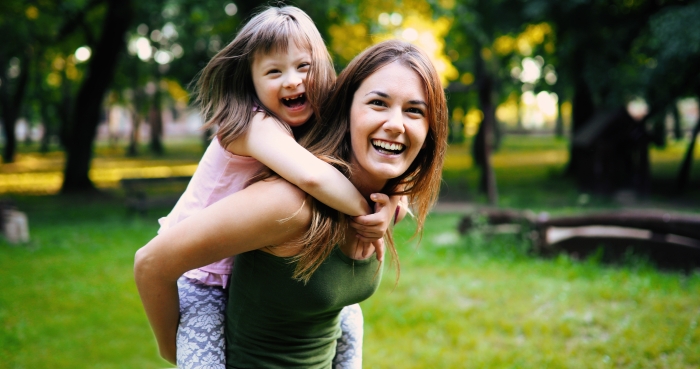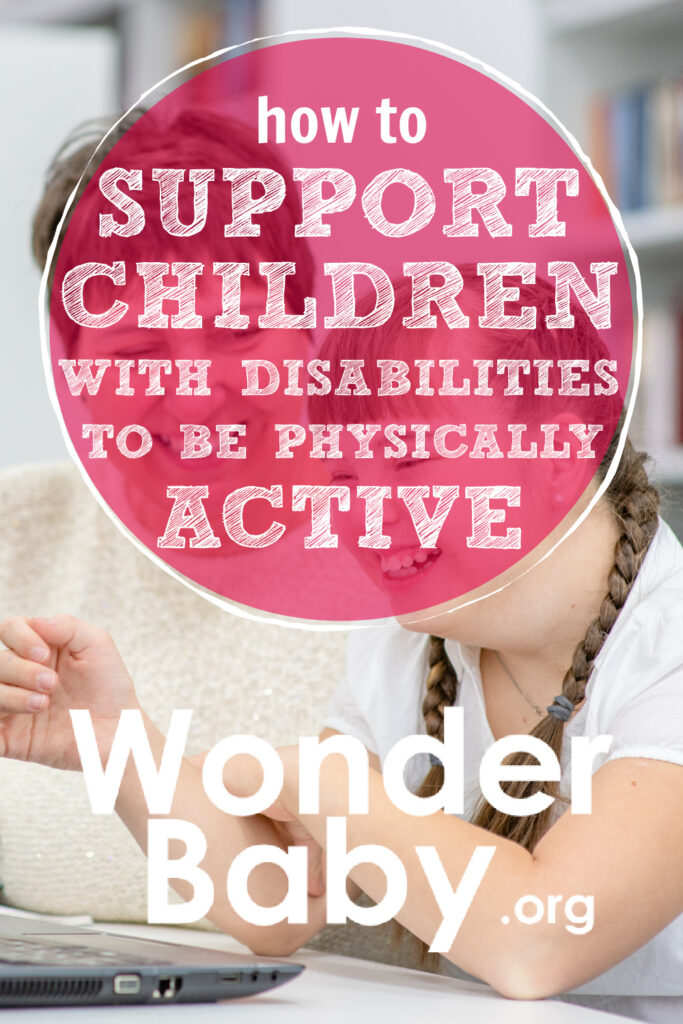How to Support Children with Disabilities to Be Physically Active

- Children with disabilities benefit physically, emotionally, and socially from physical activity.
- Tailoring activities to your child’s abilities and interests enhances engagement and enjoyment.
- Adaptive equipment and modifications can make sports and physical activities more accessible.
- All children should aim for 60 minutes of physical activity a day. This can be spread throughout the day.
- Pediatricians, physical therapists, and occupational therapists can support effective engagement with physical activity.
I remember the first time I watched the Paralympics as a kid. I was so inspired by everything I saw, shattering any preconceptions of what people with disabilities could and couldn’t take part in. Witnessing the feats of these incredible athletes demonstrated the potential for all disabled children to engage in physical activities.
Every child deserves the chance to experience the physical, social, and emotional benefits of regular exercise, regardless of their physical needs.
Parents and carers play a crucial role in encouraging their children to be active. By modifying activities, using adaptive equipment, and collaborating with professionals, we can encourage all children to live an active life.
Benefits of Physical Activity for Kids With Disabilities

Regular physical activity offers numerous benefits for all people. It’s important to find ways to include disabled children in physical activities so they can experience these benefits too.
Some of the main advantages are:
- Improves overall health and well-being, including cardiovascular fitness
- Boosts self-esteem and provides a sense of accomplishment
- Improves motor skills, muscle strength, and coordination
- Contributes to social skills and social inclusion
- Reduces the risk of chronic health conditions
- Builds up the ability to perform daily activities
- Helps to discover passion and joy!
Additionally, physical activity provides a platform for children to explore their abilities, develop confidence, and experience a sense of belonging within a community.
7 Ways to Promote Physical Activity for Kids With Disabilities
Children with physical disabilities may feel that they can’t do as much as other children and may choose to opt out of physical activities. We can help change that by providing the right support systems. By doing so, we can empower them to actively engage in fitness activities and encourage their desire to join in.
Individualize Your Approach
Arguably the most important consideration is to tailor activities for your child.
Every child has different abilities, needs, and interests. Planning something specific will make the activities more enjoyable and engaging for them.
For example, if your child is a wheelchair user and loves music, perhaps they would enjoy wheelchair dancing.
Modify Activities
Part of tailoring activities includes modification to ensure accessibility.
Using adaptive equipment or changing the rules of the activity to enable participation can help your child to take part.
Join an Inclusive Sports Team
Group sports are wonderful for promoting social interactions and teamwork skills. Seek out teams who can offer an inclusive environment and will adapt their training to enable participation.
Children with disabilities can absolutely engage in sports alongside their peers with careful planning.
Join a Specialized Adaptive Team
There are various community programs and organizations that offer adapted physical education or sports programs. This can be a great choice if your child would benefit from specialist activities and trained professional support.
There are adaptive teams available for a wide range of sports. Take a look at Move United for locations near you.
Use Adaptive Equipment
Specialized adaptive equipment can play a crucial role in helping children with disabilities to take part in sports that they may not have previously considered possible for them.
From adaptive swimming fins to climbing harnesses, there are so many choices. Check this list of adaptive equipment providers.
For example, adaptive bikes can make biking accessible for kids with limited motor control.
Family Fun
Our kids want to belong and have positive interactions with their family unit. One of the most effective ways to encourage children to engage in regular physical activity is to involve the whole family.
You’ll be showing them that you value physical fitness and building your bond in the process!
Role-Models
Watching role models can be a powerful way to encourage children with disabilities to engage in physical activity. This might mean watching Paralympic athletes competing at the highest level or local individuals with disabilities participating in community sports events.
Role models show children that their disabilities don’t define them and that they too can enjoy the benefits of being active.
How Often Should Disabled Children Engage in Physical Activity?

Physical activity recommendations for disabled children may differ based on factors like age, abilities, and overall health.
As a general guideline, the Centers for Disease Control and Prevention (CDC) suggest that children 6-16 years old aim for at least 60 minutes of moderate to vigorous physical activity each day.
They specify that “Youth with disabilities should work with a healthcare professional or physical activity specialist to understand the types and amounts of physical activity appropriate for them. When possible, children and adolescents with disabilities should meet the key guidelines.”
How Can Physical Activity Be Incorporated Into a Daily Routine?
Keep in mind that the 60-minute goal can be reached through various activities spread out throughout the day.
Making daily movement a habit will help you to stay consistent. Some tips on how to build this daily practice:
- Set a schedule: Choose times that work within your existing schedule to increase your chances of sticking to a routine!
- Create a visual timetable: Use picture cards to help your child to understand where physical activities will fit into their day.
- Incorporate physical movement into daily tasks: Look for opportunities to add some extra movement to your days – bicep curls with the grocery bags, anyone?
- Break it into shorter sessions: You don’t have to exercise for 60 minutes in one go. Try several short bursts of activity throughout the day instead.
- Make it fun! Your child is likelier to stick with a daily habit if the activity is enjoyable. Try a wide range of sports to find something that they find fun.
Are There Any Precautions or Safety Concerns I Should Be Aware of When My Child Engages in Physical Activity?
While physical activity has many benefits for children with disabilities, it’s of course essential to be aware of any safety risks.
When it comes to children, we can’t avoid all accidents, but we can minimize risk in some ways.
Consult Healthcare Professionals
As per CDC recommendations, healthcare providers can provide important guidance based on your child’s specific needs.
Before starting any new physical activity, consult with your child’s health team or specialist for personalized safety advice.
Use Safe Equipment
Ensure that your child is using appropriate equipment and adaptive devices that are fitted correctly and safe to use.
This includes any additional items they use, such as helmets, braces, or assistive walking devices.
Warm Up and Cool Down
To reduce the risk of injury, we need to prepare the body for exercise and stretch muscles when we are finished.
Make sure you plan a warm-up and cool-down for physical activities. If your child has a physical therapist, they can help you to plan a suitable program.
Stop if Painful
If your child is showing any signs of pain or excessive fatigue, stop or modify their current activity.
Older children may be able to tell you when they need to stop, but you’ll need to pay close attention if your child struggles to communicate when they’re in pain.
Stay Hydrated
Encourage your child to drink plenty of water before, during, and after physical activities to stay hydrated, especially in warmer weather or during intense exercise.
Which Sport Should We Choose?

Disabled children can participate in a wide range of sports, especially with the help of adaptations and adaptive equipment.
Your choice of sport will depend on their individual needs, interests, and the available resources.
It’s recommended that you try a wide variety of sports to find what your child enjoys most.
Here are some examples of popular sports that can be adapted or modified to accommodate disabled children:
- Athletics
- Cycling
- Swimming
- Basketball
- Racket sports
- Horseback riding
There are also sports especially designed to be inclusive for disabled individuals, such as boccia and goalball.
If you need help determining if a sport can be adapted to meet the individual needs of your child, consult their healthcare provider for further advice.
Which Professionals Can Support My Disabled Child to Take Part in Physical Activities?
Your child may have a range of professionals involved in their care. Some key professionals who can provide guidance on physical activity include:
- Pediatricians or Primary Healthcare Providers: They can assess your child’s overall health and provide recommendations for suitable activities. They can also make referrals to other specialists if needed.
- Physical Therapists: A Physical Therapist specializes in evaluating and treating movement difficulties and disabilities. They can develop personalized exercise programs and recommend adaptive equipment.
- Occupational Therapists: An Occupational Therapist focuses on supporting daily living skills. They can evaluate how well your child can do things and suggest ways to make physical activities easier for them. They can also recommend strategies to improve their participation and suggest changes that can help them take part.
FAQs
Is there any specialized equipment that can help my child with a disability engage in physical activity?
Yes! There’s a whole range of equipment and devices available to support children with disabilities.
These can include adaptive bicycles, wheelchair equipment, modified sports gear, and much more.
To find the right options for your child, you can talk to healthcare experts or organizations that specialize in adaptive sports.
How can I help my child engage in sports teams if they have social anxiety?
For children with social anxiety, group sports can seem intimidating.
You might choose to start with individual physical activity to build confidence and skills before trying a group activity.
When joining a team, look for smaller supportive environments. It’s important that the adults in charge understand how to help your child with their social anxiety. With a gentle approach, team sports can provide a great opportunity for kids to improve their social skills.
Can children on the autism spectrum enjoy team sports?
Children on the autism spectrum can definitely enjoy team sports.
Every child is different and may have different preferences and challenges. But, many children on the autism spectrum can find joy and meaningful social interaction through team sports.
Adaptations can help to include your child and their individual needs. This might include visual schedules, clear instructions, sensory breaks, and reduced eye contact.
Should my disabled child join in with physical education sessions at school?
Schools have a responsibility to provide reasonable adjustments to allow all children to take part in physical education sessions.
Communication is key here. We’d recommend that you make an appointment with your child’s school to discuss how they can be included.
It can be helpful to write down a plan to guide the adaptation of activities and any necessary support. This will help to ensure your child’s meaningful participation in lessons.

Related Posts

Eye Conditions and Syndromes, Visual Impairment
Neuralink Announces Plans to Restore Sight to the Blind with Brain Chip
Elon Musk’s company Neuralink has announced plans to begin human trials of its new “Blindsight” brain chip by the end of 2025.

Special Needs
5 Spring Cleaning Tips for Families of Children with Disabilities
Spring cleaning is an opportunity to create a more accessible, organized, and supportive space for your child with disabilities. Declutter, deep clean, and refresh!

Visual Impairment
The Gift of Understanding: How a Young Child Helps His Blind Father Navigate Life
When a parent is blind, it’s natural for people to wonder how their sighted child will adapt. Will they struggle to understand their parent’s needs? Will they feel burdened by...